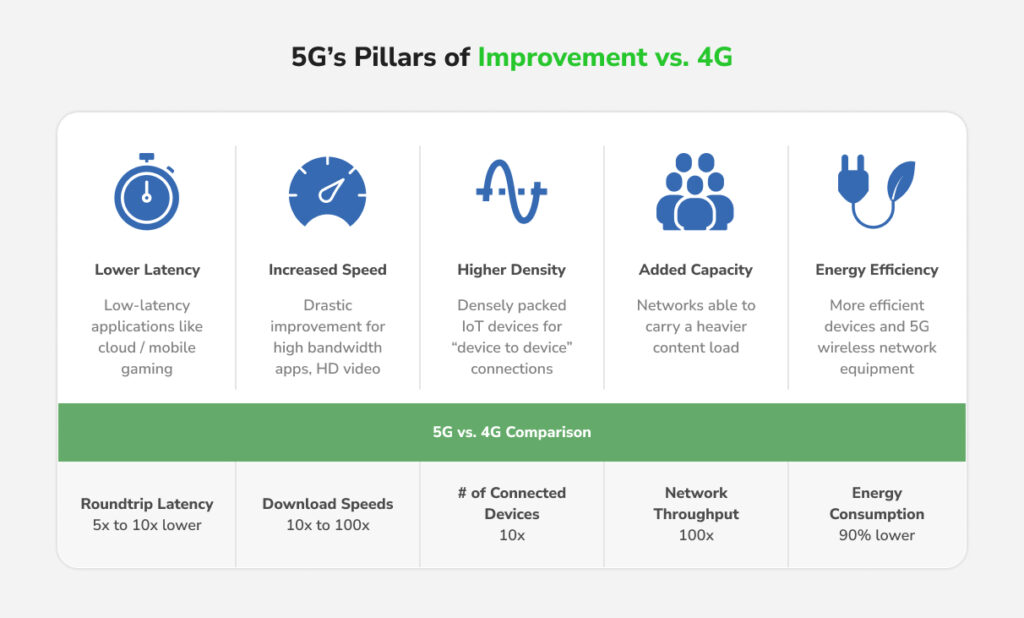How 5G Will Transform EV Charging in India by 2026
Raghav Bharadwaj
Chief Executive Officer
Published on:
27 Nov, 2025
Updated on:
27 Nov, 2025

India’s EV charging ecosystem is entering a critical phase between 2026 and 2030, when connectivity and intelligence will matter as much as the number of chargers. By mid-decade, 5G will be standard across most urban centers, and new chargers and vehicles will increasingly ship with native 5G modules. This shift isn’t just about faster mobile internet; it fundamentally changes how charging networks operate.
5G’s low latency, high device capacity, and reliable real-time communication allow chargers to authenticate users instantly, push updates without downtime, and coordinate with the grid at scale. Instead of multi-second delays common on 4G, 5G enables millisecond-level data exchange, making continuous monitoring and predictive maintenance practical for thousands of chargers simultaneously.
In this blog, we explore:
- How 5G enhances the speed, reliability, and uptime of EV charging
- Why 5G is better suited than 4G for India’s next generation charging infrastructure
- What a fully 5G-enabled charging session will look like in 2026
How does 5G improve EV charging speed and reliability?

5G networks promise ultra-fast, ultra-reliable links that make EV charging more seamless. Unlike 4G, 5G delivers near-instantaneous data exchange with latency under 1 millisecond.
A charging station can instantly recognize your car, verify credentials, and begin power transfer with virtually no delay. Real-time connectivity also means chargers report their status continuously.
For example, 5G-enabled stations could detect a fault and reboot within milliseconds, notifying technicians immediately. Today, up to 38% of India’s public chargers are non-functional at any time. With 5G’s predictive diagnostics, uptime can rise above 99%. In short, faster and more reliable communication ensures chargers stay online and operate at peak performance.
Why 5G is better than 4G for EV charging infrastructure

The advantages of 5G go beyond speed. It’s designed to support massive IoT and critical services simultaneously. For example, industry specs target 5G to handle up to 1 million devices per square kilometer with latencies as low as 1 ms, far beyond 4G’s capabilities.
Ericsson notes that 5G can handle as many as 1 million devices per square kilometer, whereas 4G struggles in crowded areas. In EV networks, this means thousands of chargers and EVs can communicate with the grid without contention. Moreover, 5G also enables network slicing, creating dedicated virtual channels. In practice, a charger could use one high-priority 5G slice for time-critical tasks like authentication and billing and another slice for routine telemetry. These slices guarantee that critical EV communication is never delayed. Together, multi‑Gbps bandwidth, millisecond latency, device density, and slicing make 5G infrastructure far more robust and efficient than 4G.
Will 5G reduce charging costs or wait times?

5G doesn’t directly cut the energy bill, but it enables smarter charging that lowers costs and queues. For instance, a big benefit of 5G connectivity is smart scheduling. Stations can continuously share live data (station load, queue length, and grid demand) and coordinate charging to off-peak hours or less-used sites.
A pilot in Delhi showed that shifting charging away from peak hours cuts customer bills by approx. 13%. With 5G, such savings could become routine.
Likewise, rapid 5G links also let apps display real-time charger availability, helping drivers avoid queues. Ultra-low latency reduces the start/stop handshake from 10-20 seconds on 4G to just 2-3 seconds. In sum, 5G-connected stations balance load and reduce energy peaks and minimize bureaucratic delays, delivering a smoother, cheaper charging experience.
Early 5G Charging Pilots in India and the Road to 2026
Several Indian trials already hint at 5G’s role in EV charging. Indus Towers (backed by Bharti, Vodafone-Idea, and Jio) has launched pilot chargers in Gurugram and Bengaluru, while BSNL plans to install EV fast chargers at 5,000 sites nationwide, effectively turning telecom sites into charging hubs. These pilots lay the groundwork: once 5G is widely rolled out (over 465,000 5G base stations exist in India as of 2024), these sites can carry EV traffic.
Globally, platforms like EVPassport (an EV charging platform provider) have demonstrated 5G-connected charging systems in New York, halving latency and enabling real-time power balancing. Major automakers and utilities in Europe and Asia are piloting similar ideas, with regulators pushing for networked, smart chargers. By 2026, most new fast-charging stations in key markets will use 5G or advanced IoT links. For example, the EU’s new charging rules (AFIR) effectively mandate that all public chargers be networked and V2G-ready by 2024–25. This means the majority of stations built today must already support bidirectional power and “smart” features. 5G will be the default choice for many of these.
What a fully 5G-enabled charging session will look like in 2026?
Imagine pulling into a highway charging plaza in 2026:
Instant connection: Your EV greets the charger over 5G in under 100ms as soon as you park.
Network slicing: One slice secures payment, and another streams live telemetry to the operator (socket temperature, grid load).
Dynamic pricing: As you plug in, the rates adjust in real time to encourage the use of green energy.
Seamless billing: Payment completes in seconds, and charging begins almost immediately—maybe 2–3 seconds after arrival instead of 15–20 seconds today.
Fail-safe measures: If a glitch occurs, the charger auto-resets the module or switches to a backup instantly. When you’re done, the session log has already synced to the cloud, giving you real-time receipts.
In short, the whole session feels like a swift digital transaction rather than a waiting game.
Where 5G Fits in the Future of Charging
- Remote management & maintenance: Operators can monitor each charger’s health in real time and push software updates or fixes remotely. That means fewer breakdowns and faster repairs.
- Driver app integration: Apps can show charger availability, reserve slots, and handle payments instantly. EVPassport’s platform, for example, integrates with Google Maps and Apple Pay so drivers see charger locations on their map and pay instantly.
- Grid-aware scheduling: 5G-connected chargers can communicate with the grid to optimize load and reduce costs. In Europe and other regions, new smart-charging regulations already require this level of connectivity. One analyst notes that connected chargers can even be configured to only charge when energy prices are low, lowering costs for everyone. If ten EVs plug in at once, the station can intelligently divide available power among them so as not to overload the circuit.
- Ultra-fast authentication & payments: 5G networks will make user transactions nearly instant. Instead of waiting several seconds, authentication on 5G can complete in milliseconds, making charging as quick as fueling at a gas pump.
Together, these features improve reliability and throughput. In congested urban areas, 5G-connected charging hubs will allow dozens of vehicles to charge simultaneously without glitches, and smart charging stations will dynamically allocate power where it’s needed. By 2026, 5G-powered smart chargers will be as commonplace as Wi-Fi in coffee shops.
Final Thoughts
In short, 5G is the missing piece that will make EV charging truly smart and seamless. By 2026, we expect charging networks to leverage 5G for ultra-fast, reliable connectivity, enabling data-driven optimization at every level. Trials already show that 5G-connected chargers are faster and more dependable. Analysts agree that communications tech in chargers can have a considerable impact on the energy costs and overall user experience. In our view, the era of digital, data-backed EV charging is arriving, and by mid-decade, charging your car will be as straightforward as charging your phone.

Frequently Asked Questions
Will 5G make home EV chargers faster or smarter?
Mostly smarter. Home charging speed depends on AC power limits, not connectivity. But 5G can enable better remote monitoring, scheduled charging, solar integration, and predictive maintenance.
Do EV owners need a 5G-enabled car to benefit from 5G charging stations?
No. Even if the vehicle doesn’t have 5G, the charger itself uses 5G for authentication, payments, grid coordination, and uptime monitoring. A 5G-equipped EV simply enables deeper diagnostics and even faster handshakes.
Will 5G increase data costs for charging operators?
Not significantly. 5G IoT plans are typically priced per device at low monthly rates. Operators save more through improved uptime, fewer site visits, faster fault diagnosis, and smarter load management.

![Top EV Launches in India 2025: Cars, Scooters and 3-Wheelers [+Bolt.Earth Charger Compatibility]](https://bolt-wordpress.bolt.earth/wp-content/uploads/Top-EV-Launches-in-India-2025_-Cars-Scooters
-3-Wheelers-Bolt.Earth-Charger-Compatible.jpg)
Dec 08, 2025 • EV Technology and Trends
Top EV Launches in India 2025: Cars, Scooters and 3-Wheelers [+Bolt.Earth Charger Compatibility]
Read More


